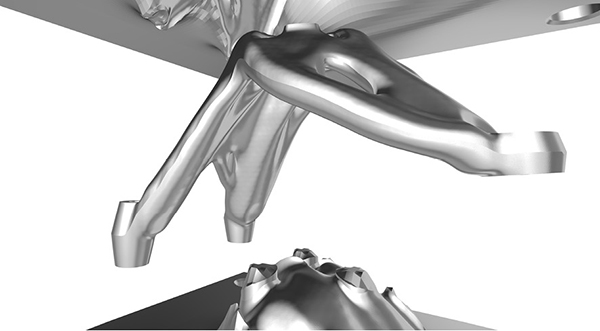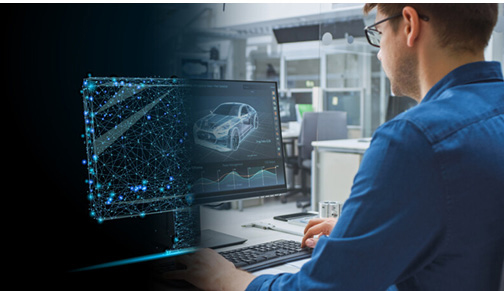
AI, machine learning and simulation go together. Though such technologies are not new, they are in emergence and many of their applications are in early adoption. The culmination of this technology will manifest in widespread and mainstream use of generative design. Image courtesy of Onshape/PTC.
Latest News
June 1, 2021
Design and simulation software tools are increasingly incorporating artificial intelligence (AI) and machine learning (ML) to accelerate engineering design performance and aid in decision-making and design space exploration.
As these and other applications are used, the engineer has many potential benefits, along with sone challenges of incorporating the technology into the design cycle and further applying AI in other areas of the manufacturing process.
A New Era of Design?
“AI simulation is ushering in a new era of design and computer-aided engineering where AI will leverage data, predicted or measured, to push virtual engineering to the next level,” says Roger Assaker, CEO of MSC Software, part of Hexagon’s Manufacturing Intelligence division. “What used to take days or weeks can now be accomplished much quicker, often within minutes or hours.
“Leveraging AI and machine learning can produce simulations that cut significant time off the design and engineering (D&E) processes by validating designs quickly and efficiently,” Assaker says. “It also acts as a democratization tool as it exposes non-experts to the design possibilities in an easy-to-understand format. It opens the world of simulation to non-finite element experts.”
Greg Brown is a product management fellow at Onshape. He joined PTC in 1997 as a simulation specialist. He believes that AI and machine learning (ML) are a suitable combo, but have struggled to live up to their practical value until this point.
“Simulation has roots back to the beginnings of digital computers, and approaches such as finite element analysis have been employed for half a century or more, especially in aerospace applications,” Brown adds. “However, even as the precision and breadth of physics being considered has exponentially risen, the mainstream engineers in consumer products, heavy industrial and to a large extent automotive industries have, in my opinion, been underserved.”
The “holy grail” for software vendors, according to Brown, has always been to tap into the sizable designer simulation market, and to date, for whatever reason, this has eluded most attempts.
“On the other hand, a confluence of technologies that have emerged in the last couple of years (including graphics processing unit based solvers, cloud and SaaS implementations and accessible AI and ML) could change the game for designer simulation,” he notes.
FEA and Reduced Order Models
Larry Williams is a distinguished engineer with Ansys who says the use of finite element analysis (FEA) has been instrumental in solving problems with unprecedented accuracy. Such use falls in sync with the benefit of algorithms and optimization for generative design.
“Our electromagnetic analysis and structural analysis finite element solvers have long used automated procedures to refine the finite element mesh where needed,” Williams says. “The software has built-in indicators to identify locations to place additional elements into the mesh as demanded for ultimate accuracy. This results in accurate solutions while minimizing compute memory resource requirements and simultaneously speeding solutions.”

Williams explains that another mature example of ML in simulation is the generation of accurate reduced-order models (ROM). Ansys’s non-linear ROM technology brings physics-based detailed simulation models when near instantaneous results are needed.
“The higher level of accuracy and wider range of applicability that these non-linear ROMs achieve relative to conventional ROMs are a result of the innovative use of neural nets and other ML methods in the training and derivation of the ROMs,” he says.
Challenges In Using AI and ML
Adam Weaver is a manager with Fluids Engineering Solutions at Rand Simulation. He emphasizes that related software applications are tools, but there’s still cognitive interaction required to apply them properly.
“First and foremost is the education of users on the workflows that need to be implemented. Simulation in general requires an understanding of advanced physics, numerical process and quantification of uncertainty, among other things. The scripting of optimization methods demands an even tighter grasp,” Weaver says.
“As a result, the field tends to be sown with doubt any time it is being used by those without the proper experience level,” he adds. “Simply put: the tool greatly improves our ability to design, but it will not build the house for you. In this analogy, the inherent difference is that people have come to accept that hammers cannot build homes, but they tend to think simulation automatically solves problems; when they see inaccurate simulations, they often blame the tool, not the person wielding it.”

Weaver says there’s still room for growth and improvement in the use of simulation tools, while noting significant strides as simulation undergoes democratization.
“As the tools are further developed, the learning curve is dropping and the barrier to entry is coming down slowly. Correlatively, more academic focus is being applied on these fields, leading to a workforce more suited for this type of work,” he says.
Xun Jiao is an assistant professor in the Department of Electrical and Computer Engineering at Villanova University. He narrows the challenges down to two significant ones in using AI, ML and simulation technology tools.
“Two challenges exist: the accuracy—developing a model that can describe a very complicated physical process accurately can be quite challenging. Traditionally, people use physics-based modeling methods such as analytical modeling but now people started to use more and more AI methods for modeling in a data-driven way,” says Jiao. “[Then there’s] the speed—simulation can be quite slow, depending on the level of detail the simulation is trying to capture.”
He provides an example of simulating the functional correctness of a chip under varying workload environments and operating conditions, which can be slow. He also describes a recent paper that he was part of that proposed an AI/ML-based model to serve as an alternative to conventional simulation tools, which, according to Jiao, “achieves over 50X speed up, with high accuracy.”
Some of the additional challenges in embracing AI and ML relate to the availability and access of such tools.
“This approach is computationally intensive,” says Chris Nicholson, CEO of Pathmind. “Ideally, you have some form of elastic compute that allows you to run many experiments at once. That is, you need easy access to infrastructure. The latest AI tools are not available with all design software. It can be hard to find the right tooling stack that integrates with everything you need. In addition, sometimes engineers don’t have the training required to succeed with AI.”
Focus on Benefit
Despite the challenges, the benefits of employing AI, ML and innovative simulation software applications are many. This combination acts in tandem to streamline and expedite workflows, while shortening design timelines and reducing costs.
Gleb Gusev is the chief technology officer at Artec 3D, manufacturer of 3D hardware and software. He highlights the benefits of how new technologies such as AI and ML improve testing, while meeting specifications and coming up with solutions—all at a lower total cost.
These new technologies offer “a faster iteration and design process, as your design is created mainly by algorithm with only the constraints for your requirements added by hand,” says Gusev. “It is easier and cheaper to test as you will already have viable solutions that will satisfy your requirements and will therefore require less prototyping.
“You are able to explore a wider range of possible design solutions as AI can generate many solutions that won’t be limited by your personal experience and expertise,” Gusev adds. “You can then explore and improve on these solutions.”
Raghi Iyengar is president of DSi-Digital’s Manufacton and ViZZ products, which are used in construction design. He points out that software applications may be collaborative and used by a dispersed workforce, which allows others in the supply chain to collaborate.
“The biggest benefit of AI and simulation, with products such as ViZZ and Manufacton, is the continued effort to productize construction with complete visibility and access to project data,” he says. “Through accessing insights around prior supply chain relationships and product experiences, the industry is better equipped to make construction projects faster, cheaper, better and greener.”
There’s also the cost savings reaped from cost avoidance in physical testing and running the systems.
“This is the real opportunity: reduce the cost of testing and running systems by doing more of the testing on software, rather than in the real world. More accurate, dynamic and highly dimensional simulations can model more potential instantiations of a product in the real world, avoiding costly tests that only serve to find out failure points,” says Ash Fontana, managing director of Zetta Venture Partners.
AI, ML, and Simulation—Looking Forward
MSC Software’s Assaker expects these new technologies to continue to influence and disrupt manufacturing. Manufacturing is seemingly becoming smarter with each new release and the momentum is growing.

“AI and ML complement physics-based simulation perfectly. AI and ML are revolutionizing manufacturing,” says Assaker. “Physics-based and data-based simulations capture data that physics-based models alone can’t capture fast or accurately enough. We see a future in which all elements of the manufacturing processes are working together to create the optimum solution through leveraging AI- and ML-enhanced simulations and modeling.”
Ansys’s Williams says he is confident in the future and expects deep learning to usher in a new era of simulation that will disrupt nearly every industry.
“Augmenting the solvers via deep learning, simulation tools will improve how engineers innovate new products, allowing them to deliver products to market faster than ever before while cutting costs,” he says. “Augmenting the applications with simulation will enable much more comprehensive training and hence more rapid adoption.”
More Ansys Coverage
More Artec 3D Coverage
More Hexagon MSC Software Coverage
More Onshape Coverage
Subscribe to our FREE magazine, FREE email newsletters or both!
Latest News
About the Author
Jim Romeo is a freelance writer based in Chesapeake, VA. Send e-mail about this article to [email protected].
Follow DE





